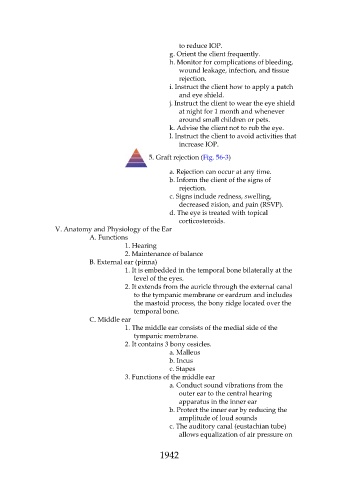Page 1942 - Saunders Comprehensive Review For NCLEX-RN
P. 1942
to reduce IOP.
g. Orient the client frequently.
h. Monitor for complications of bleeding,
wound leakage, infection, and tissue
rejection.
i. Instruct the client how to apply a patch
and eye shield.
j. Instruct the client to wear the eye shield
at night for 1 month and whenever
around small children or pets.
k. Advise the client not to rub the eye.
l. Instruct the client to avoid activities that
increase IOP.
5. Graft rejection (Fig. 56-3)
a. Rejection can occur at any time.
b. Inform the client of the signs of
rejection.
c. Signs include redness, swelling,
decreased vision, and pain (RSVP).
d. The eye is treated with topical
corticosteroids.
V. Anatomy and Physiology of the Ear
A. Functions
1. Hearing
2. Maintenance of balance
B. External ear (pinna)
1. It is embedded in the temporal bone bilaterally at the
level of the eyes.
2. It extends from the auricle through the external canal
to the tympanic membrane or eardrum and includes
the mastoid process, the bony ridge located over the
temporal bone.
C. Middle ear
1. The middle ear consists of the medial side of the
tympanic membrane.
2. It contains 3 bony ossicles.
a. Malleus
b. Incus
c. Stapes
3. Functions of the middle ear
a. Conduct sound vibrations from the
outer ear to the central hearing
apparatus in the inner ear
b. Protect the inner ear by reducing the
amplitude of loud sounds
c. The auditory canal (eustachian tube)
allows equalization of air pressure on
1942

